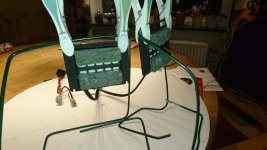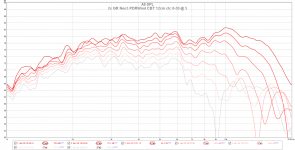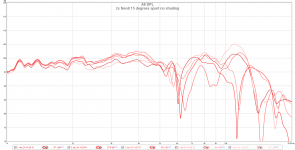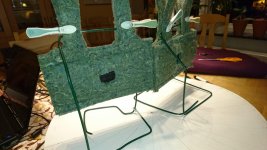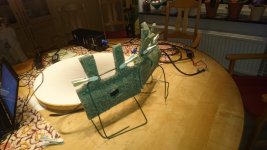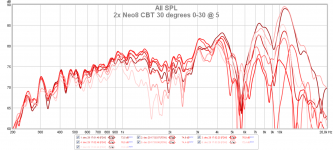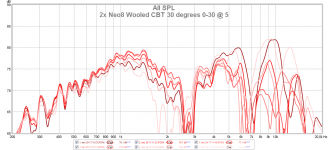I'm up to my experiments again, and this time I want to tackle the ever present dipole tweeter problem.
My current main speakers are 10" woofer, then a Neo8 in the midrange and a GR Neo3 as tweeter. Horizontally it measures great but if you stray off the middle it starts to lobe and the off axis is not as good.
Most of my experiments have been complete failures but I think I have hit the jackpot on one:
It is inspired by Keeles experiments with dipole CBT arrays: Implementation of a Dipole Constant Directivity Circular-Arc Array
A Mini-CBT vertical array of Neo3 tweeters, more specifically Mini as in 5 drivers in a non ground plane 90 degree arc. The 0 degrees in the measurement is in the center of both, and then in 5 degree increments to the right. The idea is just to see how good the transition from driver to driver is.
This experiment is only with two drivers, one at full power and the other at -2 dB. (cosine CBT function). This would be the vertical dispersion, however, and I'm suprised it measured so well. Without the -2 dB shading it was awful but with it it measures beautifully. As you can see in the picture the tweeters aren't even that close to each other, but it still measures that good.
Next step is to try a full array with 5 tweeters. My spreadsheet says that they should be at the following angles and corresponding shading:
34 cm radius, drivers 10 cm spaced apart to give me some headroom in the construction.
[Degree to center of driver, shading amount]
-67.4 degrees, -8.3 dB
-33.7 degrees, -1.6 dB
0 degrees, 0 dB
33.7 degrees, -1.6 dB
67.4 degrees, -8.3 dB
The next step is to try such an array and see if it works. The jump from the 33 degree and the 67 degree in shading is a lot, the question here is if we would be better off with another driver in the array to smooth this out or if it it works great anyway. 10 drivers is cheaper than 14 though so if 5 are good enough then that is nice.
So not conclusive results yet but I found it interesting enough to share =)
My current main speakers are 10" woofer, then a Neo8 in the midrange and a GR Neo3 as tweeter. Horizontally it measures great but if you stray off the middle it starts to lobe and the off axis is not as good.
Most of my experiments have been complete failures but I think I have hit the jackpot on one:
It is inspired by Keeles experiments with dipole CBT arrays: Implementation of a Dipole Constant Directivity Circular-Arc Array
A Mini-CBT vertical array of Neo3 tweeters, more specifically Mini as in 5 drivers in a non ground plane 90 degree arc. The 0 degrees in the measurement is in the center of both, and then in 5 degree increments to the right. The idea is just to see how good the transition from driver to driver is.
This experiment is only with two drivers, one at full power and the other at -2 dB. (cosine CBT function). This would be the vertical dispersion, however, and I'm suprised it measured so well. Without the -2 dB shading it was awful but with it it measures beautifully. As you can see in the picture the tweeters aren't even that close to each other, but it still measures that good.
Next step is to try a full array with 5 tweeters. My spreadsheet says that they should be at the following angles and corresponding shading:
34 cm radius, drivers 10 cm spaced apart to give me some headroom in the construction.
[Degree to center of driver, shading amount]
-67.4 degrees, -8.3 dB
-33.7 degrees, -1.6 dB
0 degrees, 0 dB
33.7 degrees, -1.6 dB
67.4 degrees, -8.3 dB
The next step is to try such an array and see if it works. The jump from the 33 degree and the 67 degree in shading is a lot, the question here is if we would be better off with another driver in the array to smooth this out or if it it works great anyway. 10 drivers is cheaper than 14 though so if 5 are good enough then that is nice.
So not conclusive results yet but I found it interesting enough to share =)
Attachments
Or possibly: Since it is a dipole and we get the 90 degree nulls kinda for free maybe we can set the "skip driver cutoff" from -12 dB higher to say -6 dB thus making the arc bigger with the same number of drivers. It would also reduce the shading jump to the outermost drivers.
That would result in the following shading:
0 0
26.04353614 -0.9300183837
52.08707228 -4.230082061
That would result in the following shading:
0 0
26.04353614 -0.9300183837
52.08707228 -4.230082061
Last edited:
-wouldn't this be more appropriate with Neo 8's or 10's? (..or Radian's larger offerings, or longer AMT's)
Cool project! Looking forward to your progression. What are the proposed positions of all drivers on your baffle?
-wouldn't this be more appropriate with Neo 8's or 10's? (..or Radian's larger offerings, or longer AMT's)
Possibly but would it be harder to construct the arc?
I actually did try with Neo8 first:
It didn't work at all, that was before I tested shading so might be worth revisiting to see if it fixes things. Especially considering that the Neo3 measured like garbage before shading too.
It didn't work at all, that was before I tested shading so might be worth revisiting to see if it fixes things. Especially considering that the Neo3 measured like garbage before shading too.
Attachments
The big elephant in the room here is that the planar drivers have narrow vertical directivity out of the box. This will change things for the way the CBT works as there might be nulls in the vertically changing listening position.
Later,
Wolf
Later,
Wolf
The big elephant in the room here is that the planar drivers have narrow vertical directivity out of the box. This will change things for the way the CBT works as there might be nulls in the vertically changing listening position.
Later,
Wolf
Exactly, hence why measuring the vertical dispersion in the array as I know the horizontal is already good enough.
OllBoll,
it would be great if we could make it work with one neo8 and one neo3
i mean using neo8 vertical without low pass
and adding a neo3 on top with an angle such that the sum is flat at all listening positions (sitting and standing)
could it be done?
it would be great if we could make it work with one neo8 and one neo3
i mean using neo8 vertical without low pass
and adding a neo3 on top with an angle such that the sum is flat at all listening positions (sitting and standing)
could it be done?
I believe you'll get better polars if you add some shallow fins, like Follgott did in the project above.
Basically you don't want the "fins" to extend very far, just enough to keep the radiation from the NEO3's apertures from interfering with each other.
See : Line array prototype (with waveguide and CBT shading)
OllBoll,
it would be great if we could make it work with one neo8 and one neo3
i mean using neo8 vertical without low pass
and adding a neo3 on top with an angle such that the sum is flat at all listening positions (sitting and standing)
could it be done?
I'm not sure it would work, or at least not in the traditional CBT shading way. My measurements are in the vertical plane and only in between the drivers, so to extend it to say +- 75 degrees you would need more drivers. The vertical dispersion of the Neo8 is not the same as that of the Neo3 so you want to cross low. I crossed at around 2.2 khz on my earlier speaker.
If I add wool and make a semi PDR Neo8 then I can get the horizontal dispersion great all the way to 15 khz so usable without a tweeter, if not for the pitiful vertical dispersion.
And in my experiments to CBT the Neo8 the results aren't as smooth as the Neo3 test:
Those experiments are with 37cm radius, -1.3 dB shading.
Attachments
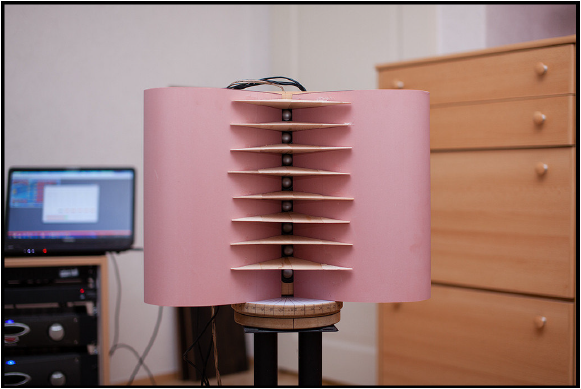
I believe you'll get better polars if you add some shallow fins, like Follgott did in the project above.
Basically you don't want the "fins" to extend very far, just enough to keep the radiation from the NEO3's apertures from interfering with each other.
See : Line array prototype (with waveguide and CBT shading)
Sure but then the speaker becomes huge =)
I'll also get problems crossing the midwoofer to the Neo3 array, ideally I want the midwoofers to be beside the neo3 array. I tried such a configuration with a waveguide around the neo3 but the bigger dipole baffle started making the response much uglier than minimalistic baffle. I could solve it by going even bigger but I want a non huge speaker.
Also the plot in #1 is the vertical dispersion with 2 drivers, which if it extends to +- 90 degrees with 5-7 drivers is already good enough.
- Home
- Loudspeakers
- Multi-Way
- Dipole Mini-CBT array of Neo3 tweeters
